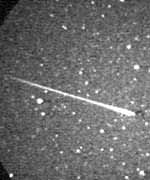Scientists using measurements from NASA’s Solar Radiation and Climate Experiment (SORCE) satellite have discovered that Venus and sunspots have something in common: they both block some of the sun’s energy going to Earth.
Using data from NASA’s SORCE satellite, scientists noticed that, when Venus came between the Earth and the sun on June 8, the other planet reduced the amount of sunlight reaching Earth by 0.1 percent. This Venus transit occurs when, from an earthly perspective, Venus crosses in front of the sun. When it happens, once every 122 years, there are two transits eight years apart. The next crossing happens in 2012 and will be visible to people on the U.S. West Coast.
“Because of its distance from Earth, Venus appeared to be about the size of a sunspot,” said Gary Rottman, SORCE Principal Investigator and a scientist at the Laboratory for Atmospheric and Space Physics (LASP), at the University of Colorado at Boulder. The SORCE team had seen similar reductions in the sun’s energy coming Earthward during the October 2003 sunspot activity.
In October 2003 the Earth-bound sunlight dimmed 0.3 percent for about four days, due to three very large sunspot groups moving across the face of the sun.
“This is an unprecedented large decrease in the amount of sunlight, and it is comparable to the decrease that scientists estimate occurred in the seventeenth century,” Rottman said. That decrease lasted almost 50 years, and was likely associated with the exceptionally cold temperatures throughout Europe at that time, a period from the 1400s to the 1700s known as the “little ice age.”
Solar conditions during the little ice age were quite different, as there were essentially no sunspots. Astronomers of the time, like Galileo, kept a good record of sunspot activity before and during the period, encountering only about 50 sunspots in 30 years.
Rottman said, “Something very different was happening during the seventeenth century, and it produced a much more permanent change in the sun’s energy output at that time.” Today, the large sunspots are surrounded by bright areas called “faculae.” Faculae more than compensate for the decrease in sunlight from sunspots, and provide a net increase in sunlight when averaged over a few weeks.
The large number of sunspots occurring in October/November 2003 indicated a very active sun, and indeed many very large solar flares occurred at that time. SORCE observed the massive record-setting solar flares in x-rays. The flares were accompanied by large sunspots, which produced a 0.3 percent decrease in the sun’s energy output. SORCE simultaneously collected the energy from all wavelengths, something that had never been done before.
“The SORCE satellite instruments provide measurements of unprecedented accuracy, so the sun’s energy output is known with great precision, and precise knowledge of variations in the sun’s energy input to Earth is a necessary prerequisite to understanding Earth’s changing climate,” said Robert F. Cahalan, SORCE Project Scientist and Head of the Climate and Radiation Branch at NASA’s Goddard Space Flight Center, Greenbelt, Md.
The SORCE measurements provide today’s atmospheric and climate scientists with essential information on the sun’s energy input to the Earth. These measurements also will be valuable to future scientists, who will be relating their view of the world back to conditions existing today. Likewise Galileo’s findings about the sun almost 400 years ago have increased in value as understanding of the sun and its importance for Earth has advanced.
For more SORCE information and images on the Internet, visit:
hthttp://www.gsfc.nasa.gov/topstory/2004/0730sunblockers.html
and
http://lasp.colorado.edu/sorce/
Original Source: NASA News Release


